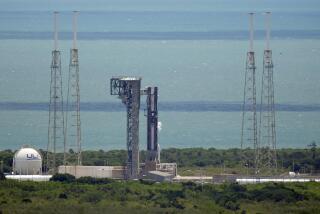Weather Puts Shuttle Liftoff in Question : Countdown 3 Hours Slow With Icy Launch Pad, Frozen Valves
- Share via
CAPE CANAVERAL, Fla. — Freezing temperatures that caked ice on parts of the launch tower put space shuttle Discovery’s countdown three hours behind schedule today, and officials said Wednesday’s planned liftoff of America’s first military shuttle mission could be delayed.
“We have one concern now, and that is the weather,” NASA spokesman Jim Ball said.
The countdown fell behind overnight when technicians were unable to get into a fuel cell loading area because of hazardous, icy conditions on the launch pad service structure. They also were hampered when a liquid oxygen valve froze shut.
The temperature dropped to 19 degrees early today, the second straight night readings dropped below freezing. More frigid weather was forecast for tonight.
“The cold temperatures remain a concern,” a National Aeronautics and Space Administration statement said. It said engineers were still evaluating how to ensure the safety of external fuel tank servicing Wednesday morning. “Also under evaluation will be the potential for ice formation on the tank,” NASA said.
Several water lines were frozen, and to provide fire protection during Monday night’s fuel cell loading, a fire department pumper truck hooked onto a 3-inch pipe extending to the pad’s 155-foot-high level where the work was being done.
The forecast called for improving weather Wednesday, with temperatures in the mid-50s expected at the secret, unannounced launch time.
The 15th space shuttle mission and the first to carry a secret Defense Department satellite is set for liftoff sometime between 1:15 p.m. and 4:15 p.m. Wednesday. The Pentagon wants to keep the precise time under wraps to hamper Soviet efforts to monitor Discovery’s payload.
The Pentagon relented a bit today and said reporters would be told when the countdown reached nine minutes before the intended liftoff, and that they would receive control center commentary from that point until the shuttle reaches orbit.
More to Read
Sign up for Essential California
The most important California stories and recommendations in your inbox every morning.
You may occasionally receive promotional content from the Los Angeles Times.













